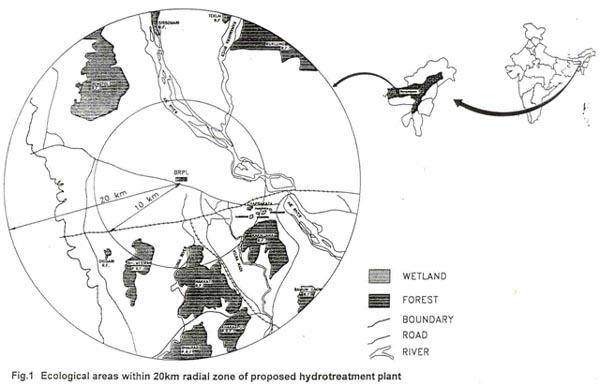Delineation Of The Study Area
|
The spatial limits for the field based study need to be carefully determined for collection of meaningful information within representative areas in a reasonable time frame. Observations on the ecological characteristic of the study area, faunal status, floral diversity, habitat quality and conservation significance are then made within the pre-defined study zone. For the purpose of this study, several considerations governed the delineation of the study area. i. The proposed expansion is a part of Schedule I industry and therefore as per the EIA notification (Anon., 1994c), requires an environmental management plan in accordance with the guidelines prepared by MoE&F (Anon., 1984). ii. As per the Guidelines for siting of industry issued by MoE&F (Anon., 1984), in respect of industrial projects particularly those which are highly polluting in nature, observations for impact assessment need to be made at least within 25km radial zone. It is evident from feasibility report (Anon., 1994a) of the proposed hydrotreatment plant prepared by BRPL that the liquid effluent and gaseous emissions will be generated during the operational phase of the project. The gaseous emissions would include sulfurdioxide and light hydrocarbons. The project authorities have made firm commitments to use fuel gas generated in the refinery and some quantity of internal fuel oil for the furnace of the proposed hydrotreatment plant. These fuels are expected to have low sulphur content and as such the sulfurdioxide content in stack gases would be much below the permissible limit. The Assam State Pollution Control Board has also considered the above fact and accordingly, the `no objection' certificate has been issued for proposed expansion. iii. The proposed site for hydrotreatment plant is within the existing BRPL complex which is an established industry in the area for more than two decades. Considering the facts given above, the spatial limits of the impacts cannot be visualised in the zone beyond the 10km radial zone of the proposed project. Even the natural life sustaining systems and the specific land uses that are more sensitive to industrial impacts, because of their specific nature and extent of fragility are not expected to be the receptors of impacts in the area beyond 10km radial zone. Hence for the purpose of this study, a 10km radial zone from the existing BRPL complex has been delineated as the study area (Fig. 1).
|
Last Updated: September 29, 2015










